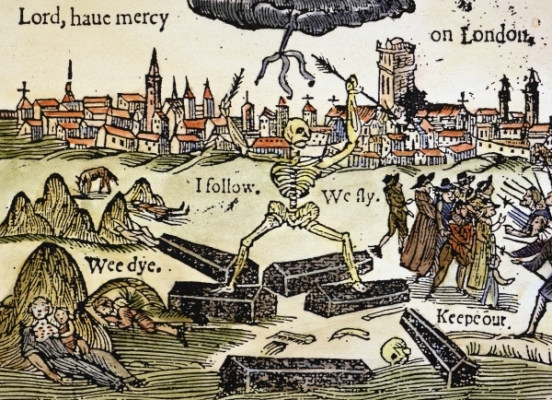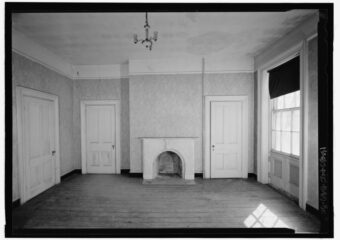Introduction
What Plagues, and what portents, what mutiny!
What raging of the sea! shaking of earth!
Commotion in the winds! frights, changes, horrors,
Divert, and crack, rend and deracinate
The unity, and married calm of States
Quite from their fixure!
(Shakespeare, "Troilus and Cressida" 1.3.96–101)
During Shakespeare’s peak writing and acting activities during the late 1500s and early 1600s, London and its environs were visited upon by plague. The plague of 1593, and the nearly continuous outbreaks from 1603–1610 had definitive effects on Shakespeare’s work (Slack 145–46; Barroll 17–18). In this essay, I address the cause of plague and describe some of the actions taken to prevent and treat plague during Shakespeare’s time. I also describe the effect plague had on Shakespeare’s working life and where references to plague manifested in some of his poems and plays.
Causes and Physical Consequences of Plague
The Plague is an infection caused by the bacillus Yersinia pestis, though it was first known as Pasteurella pestis (Slack 7; McNeill 139). The bacteria are transmitted when the rat flea Xenopsylla cheopis bites humans. Another rat flea, Xenopsylla brasiliensis, has been associated with plague infection in South Africa and Brazil (Dennis and Campbell). These fleas generally feed off the blood of the black rat, Rattus rattus, and the brown sewer Norway rat Rattus norvegicus. They maintain this relationship until the rats become sick or die. In the absence of healthy rats or other suitable rodents nearby, the hungry fleas can find their way to humans through refuge they may have taken in grain or in a variety of bedclothes, fabrics, and clothing that come into close contact with the human body.
Once in close enough proximity to humans, the fleas are thought to cause infection in two ways. One is through the bite of a “blocked” flea. A flea is blocked when ingested plague bacteria multiply within the gut of the flea to the extent that no further ingestion of blood is possible. When the starving flea bites a rat or a human, the bacteria are regurgitated through the bite wound. Otherwise, humans can be infected when breaches to the skin are exposed to flea excrement containing the bacteria. Plague infections can also be transmitted from one human to another through aerosolized respiratory secretions (e.g., coughing), but infection through flea bite is the more common cause (Barroll 84–88; Slack 7–9).
A major form of plague infection is “bubonic plague,” which is associated a dramatic swelling of lymph nodes, most commonly in the femoral and inguinal regions, but can also occur in the axillary and cervical lymph nodes. The lymph nodes that swell from plague infection are called “buboes,” and hence the name “bubonic plague” (Dennis and Campbell). Other well-known signs of bubonic plague are carbuncles and blisters that can appear anywhere on the body. The swelling of the lymph nodes is exquisitely painful, and they can eventually rupture. Subcutaneous spots that change in color from orange to black, and blue to purple also form, and during Shakespeare’s time they were referred to as “tokens” or “God’s tokens” (Slack 8). The infection progresses rapidly to high fever, headache, tachycardia, lethargy, agitation, seizures, delirium, and then multiple organ failure and death (Dennis and Campbell).
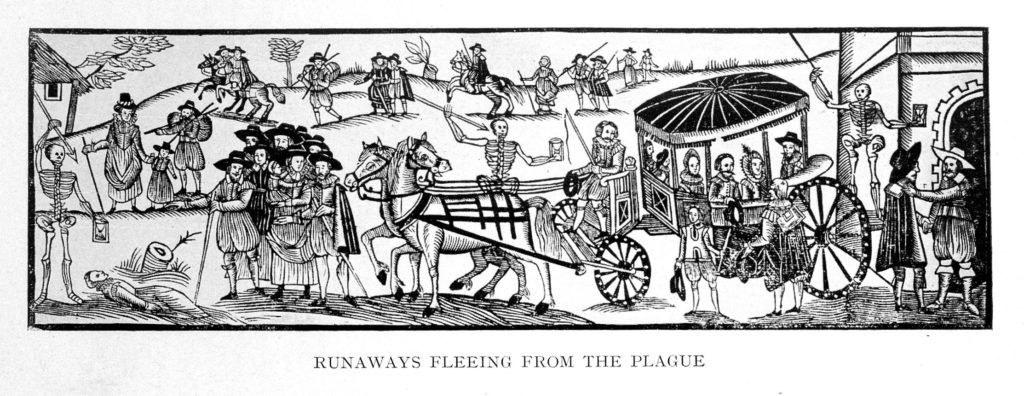
Wellcome Collection (CC BY 4.0)
Plague in Shakespeare’s Time
Shakespeare’s birth in April of 1564 fell during the particularly severe outbreak that year in Stratford-upon-Avon, the place of his birth, an outbreak that took the lives of two of his older siblings (Totaro 88–89; Barroll 73, Pollack-Pelzner). Indeed, this plague was known as “the great” plague until this distinction was passed onto the subsequent plague occurrence of 1603, and then again to the occurrence of 1625 (Slack 54). Plague was not new to Stratford-upon-Avon, or England, or the European continent at the time of Shakespeare’s birth, although it took the form of frequent epidemic outbreaks. During the sixteenth and seventeenth centuries, between one-tenth and one-third of the population would die from plague (Wear 14). The British populace during this time was either facing a plague outbreak or bracing for one.
Shakespeare’s first ten years of life came during one of the few plague-free interludes of that duration occurring between 1485 and 1665 (Slack 67–68). In addition to a ten-year, plague-free start in life, Shakespeare may have benefited from the first efforts by the government to protect the public’s health. Although behind many European states in implementing public health measures against the plague, England created and implemented a set of “Plague Orders” in 1518, which was during the reign of King Henry VIII. The Privy Council established the General Plague Orders. The separate “London Orders” were established by the Lord Mayor, alderman, and councilors of London (Wilson 14–15). Shakespeare was granted a further measure of protection while he resided in St. Olave’s parish between 1602 and 1609, which was a part of London with much lower infection rates than surrounding areas for unknown reasons (Shapiro 281–286).
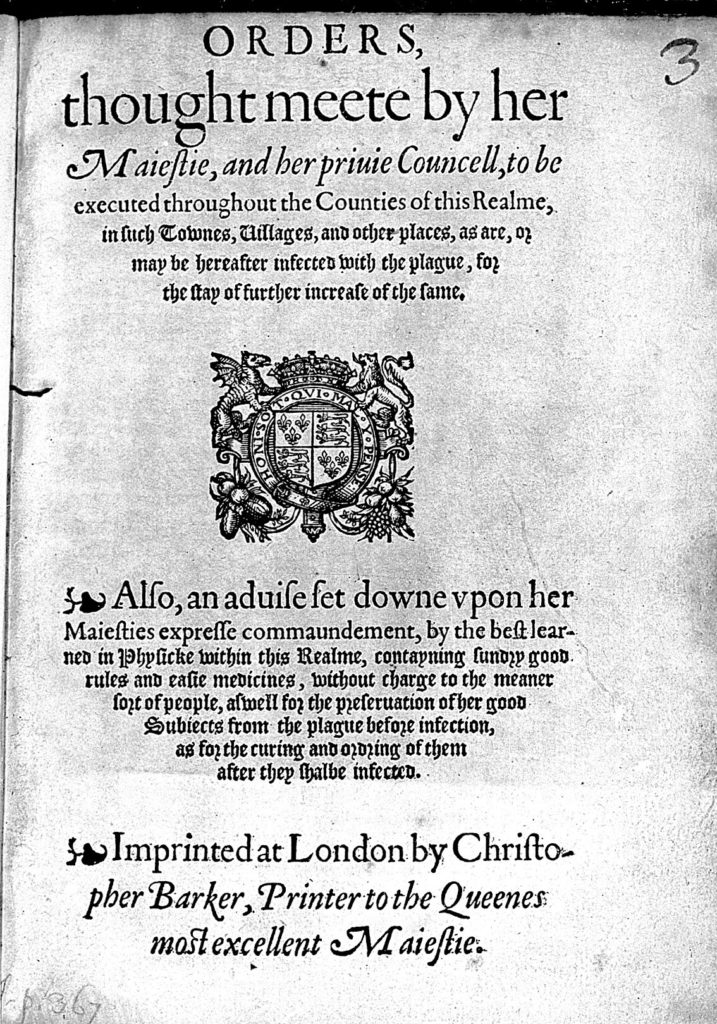
Credit: Wellcome Collection. Attribution 4.0 International (CC BY 4.0)
The emphasis on these early orders was identification and isolation of plague sources. The General Orders specified that houses with infected inhabitants should be identified by bundles of hay hung from windows for forty days. Furthermore, inhabitants of infected houses were to carry white canes in public so that people would know to avoid them. The alderman of London adopted specific elements of the General Orders slowly over the following twenty years thinking that the plague had more to do with God’s will than the contagious disease concepts the Privy Council was working under. Eventually, however, the London Orders began to reflect the approaches centering on identification and isolation, but never abandoning the link to God’s will (Slack 201–07). Infected houses were to be marked with a cross and the inscription, “Lord Have Mercy Upon Us,” as memorialized in the refrain of Thomas Nashe’s poem A Litany in the Time of Plague written during the plague of 1592–1593:
Brightness falls from the air,
Queens have died young and fair,
Dust hath closed Helen’s eye.
I am sick, I must die:
Lord, have mercy on us.
(qtd in Duncan-Jones 54)
The environment in which Shakespeare began his work as a playwright and actor was, therefore, shaped in part by the Plague Orders of 1578 and the Plague Act of 1604, which assigned various officials duties specific to plague control, in particular to improve sanitation and to minimize the spread of plague during outbreaks (Wilson 14–16). For example, a “beadle” in each ward marked houses where plague visited, while “warders” and “watchers” were assigned to watch infected houses to make sure none of the inhabitants left the premises (Wilson 19–20, 68–69; Slack 211). “Searchers” were appointed to give a report to the parish clerk on the number of deaths due to plague. “Viewers” reported infected houses to constables (Wilson 64–66). “Examiners” were appointed to ensure compliance with the Orders.
While rakers and scavengers had official duties to see that streets were clean, homeowners were expected to keep them clean as well. Efforts were also directed at cleaning up streams, rivers, and ditches, which served as repositories for all sorts of waste products. The Orders of this time carried on the tradition of doing away with the clothing and bedding of people who had been infected. These items were often burned. Domesticated animals, dogs in particular, were thought to contribute to the spread of plague before rats were implicated. Dogs were to be eliminated; the dog killers arose from this need. While many of the actions required in the Orders are consistent with modern-day management of infectious epidemics, eliminating dogs, natural enemies of rats, may have worked against them; however, “rat catchers” were common (Wilson 22–40).
Like the earliest requirements for controlling plague, the Plague Orders of 1583 put a heavy emphasis on shutting up houses where the infection existed. Houses continued to be marked and no inhabitants—sick or healthy—could leave for up to six weeks, and those who did had to repair to a house in the country and could not return for twenty-eight days. Violation of these requirements could result in arrests and beatings. Inhabitants of houses shut up because of plague infection were given support through local parishes and through a plague tax (Slack 210–11). Most of the controversy surrounding the Plague Orders was directed at these quarantine requirements, sparking Paracelsus, a leading physician of the time, to condemn these requirements as inhumane and counterproductive:
What a madness and cruel foolishness is this, that in the time of any great plague, such as are infected, you shut up in houses, set marks upon them in prison, strangle them with cares and solitariness, and kill them for hunger….Do you in this sort love your neighbour as yourself…when as at no time…there is greater need of fellowship, company, comfort and help than in the time of plague?
qtd in Slack 227
Concern over the contagious aspect of plague infection produced restrictions on activities that resulted in gatherings of many people in close proximity to one another (Wilson 49–50). Having come into their own in the mid 1500s, London playhouses became subject to these restrictions and theaters were often closed during plague outbreaks.
More may have been at work in the closing of theaters than just plague, however. Given the relatively nascent state of London playhouses, players themselves had yet to coalesce into a legitimate social category that was part of the system of guilds. They were generally viewed and treated as “’masterless men’ classed with vagrants, tinkers, and peddlers” (Barroll 9). The players were on the margin of society. They had no regular stipend or retainer. They welcomed anyone who could pay to see their plays, and so their theaters attracted large crowds of commoners. Needing to depend on large crowds was considered base during Shakespeare’s time (Barroll 11–12). It was from this standing of players and the crowds they drew that some people considered them the cause of plague infection. T. White made this case using a syllogism: “the cause of plagues is sinne, if you looke to it well: and the cause of sinnes are playes: therefore the cause of plagues are playes” (Wilson 52).
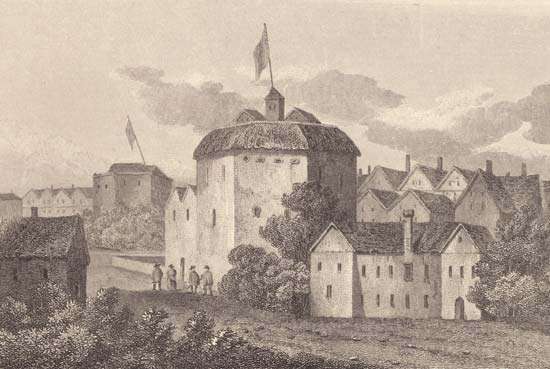
From A Brief History of Shakespeare’s Globe, April 26, 2018
https://www.southlondonclub.co.uk/blog/a-brief-history-of-shakespeares-globe
During the years Shakespeare wrote and performed in his plays, theater closings were usually based on the number of plague deaths per week; theaters would be closed when plague deaths exceeded some pre-established number per week, which was usually between thirty and fifty. Theater closings further truncated the playing seasons already affected by required closings for Lent and periods of mourning. Shakespeare had to navigate his career around frequent and prolonged loss of performance venues (Barroll 15).
Effects of the Plague on Shakespeare’s Work
Barroll makes the point that “Shakespeare’s choice of profession led him to work within a social institution subject to suspension in times perceived as dangerous for any reason at all” (15). Shakespeare was not long into his career when he first encountered a serious disruption from the closing of the theaters during the plague visitation of 1593–1594. He lost twenty months during this span that could have been used to stage plays and generate revenue. Like other playwrights of the time, he had to find other sources of income (Barroll 17–18).
It was during this interval that Shakespeare produced his two non-dramatic poems, Venus and Adonis and The Rape of Lucrece for a patron within the aristocracy, the Earl of Southhampton (Duncan-Jones 54–81). Given that Venus and Adonis was written during what Elam calls the “bubonic pause” of 1592–1593, a reference to plague should not cause surprise. Indeed, Shakespeare is clever in using his knowledge of plague as a contagious disease that can be passed by breath (Elam 22). But, he has Venus suggest to Adonis that from her love his breath could ward off plague instead:
‘Long may they kiss each other for this cure!
Oh never let their crimson liveries wear,
And as they last, their verdour still endure,
To drive infection from the dangerous year:
That the star-gazers, having writ on death,
May say, the plague is banish’d by thy breath…’
("Venus and Adonis" 505–10)
Upon the reopening of the theaters in 1594, and until the theaters were closed again nine years later in 1603 due to plague, Shakespeare wrote twenty-seven plays, or more than two-thirds of all the plays he would write during his lifetime. Over the subsequent ten years, an interval which was characterized by frequent theater closings, he would right only ten more plays (Barroll 19). Bevington wonders if Shakespeare was really slowed during this time period, however, because during that time he wrote forty-six percent of the lines across all his plays (462).
The year 1603, the first of this ten-year period, was perhaps the most devastating for playwrights who depended upon the public theaters for a major part of their living. At its peak that year, the plague claimed over three thousand lives in London. Adding to the pressures on theaters were the ordinary closings during Lent, the death of Queen Elizabeth in March, and the many coronation proceedings for King James I that were aborted due to plague outbreaks in the different regions of England. The new King proclaimed that “comedies, tragedies, histories, interludes, morals, pastoral, stage plays, and such like to show and exercise publicly to their best commodity when the infection of the plague shall cease” (qtd in Elam 19). The theaters were closed for most of the year. Playwrights had to find other sources of income (Wilson 85–113). Thomas Dekker, a contemporary of Shakespeare’s, turned to producing pamphlets, some of which included descriptions of life during this plague outbreak:
Whole housholds, and whole streets are stricken,
The sick do die, the sound do sicken,
And Lord have mercy upon us, crying
Ere Mercy can come forth, th’are dying.
No musick now is heard but bells,
And all their tunes are sick mens knells;
And every stroake the bell does toll,
Up to heaven it winde a soule.
(qtd in Wilson 97)
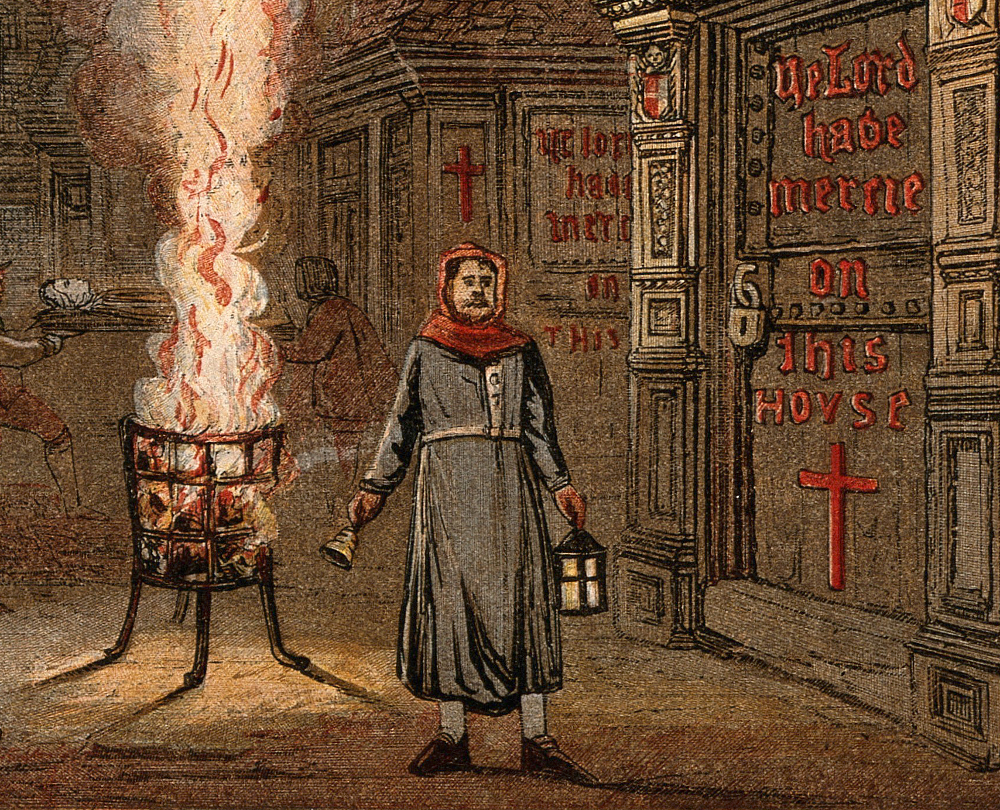
Wellcome Library, London (CC BY 4.0)
Plague continued to visit and vex London and its surrounding regions from 1604 through 1610. Other events sometimes compounded the problem such as the Gunpowder Plot of 1605 (Barroll 132). The public theaters were closed for sixty-five of the eighty-four months of those years (Barroll 173). Barroll’s analysis suggests that Shakespeare only wrote his plays when the theaters were open for business, which may explain the drop off in the rate at which he wrote plays during this period compared to the preceding period. That being the case, Shakespeare needed other sources of income (17).
Shakespeare obtained some amount of his living during these years from his involvement as an actor in the King’s Servants (also known as the King’s Players). The King’s Servants comprised an acting troupe under a royal patronage. The patronage is thought to have been arranged by William Herbert, the third earl of Pembroke, who was favored by King James I. Pembroke’s connection to the acting troupe that became the King’s Servants appears to have been through the actor Richard Burbage and not Shakespeare. Through this royal patronage, Shakespeare was able to derive revenue from performances at Court and through occasional gratuities the King provided in recognition of the hardships the closure of public theaters imposed (Barroll 23–69).
Shakespeare references plague in some of his plays, although plague never dominates any of them. In different places in his works, Shakespeare uses plague literally and in others metaphorically. He also embeds the social consequences of plague and contemporary ideas about prevention and treatment.
Timon of Athens is the play Shakespeare uses references to plague most directly and as such has been considered his most “pestilential” play (Elam 20). Timon is a charitable man who relishes giving away his fortune to fellow citizens of Athens:
We are born to do bene-
fits; and what better or properer can we call our own
than the riches of our friends? O what a precious
comfort ‘tis to have so many like brothers command-
ing one another’s fortunes.
("Timon" 1.2.102–06)
After he has depleted his riches, he seeks help from those he helped in Athens only to be refused. His anger turns him against Athens and he plots the destruction of it. Shakespeare also shows his understanding of the infectious nature of plague by having Timon wishing he could directly expose the Athens population to it: “would send them back to plague, / Could I but catch it for them” (qtd in Totaro 103). And also by his curse: “Breath infect breath, / that their society, as their friendship, may / Be merely poison!” (qtd in Totaro 107). Plague is also used as metaphor for war and genocide when Timon urges Alcibiades to attack Athens on his behalf:
Go on. Here’s gold. Go on.
Be as a planetary plague, when Jove
Will o’er some high-vic’d city hang his poison
In the sick air. Let not thy sword skip one.
(qtd in Totaro 100)
Shakespeare uses his knowledge of the role of gold in plague at the time, which was thought to be an effective agent, but he has inverted its value. Instead of associating gold with a cure for plague, he is using it to spread plague (in its metaphorical form). Totaro has suggested that Shakespeare may also be warning about “the dangers of believing that gold can single-handedly improve one’s society in plague-time” (107).
However, Shakespeare recognizes that despite the dangers gold posses, it had a place in contemporary standards of care in plague. This is illustrated in Henry IV, Part II where Prince Hal addresses his father’s crown:
The care on thee depending
Hath fed upon the body of my father;
Therefore thou best of gold art worst of gold.
Other, less fine in carat, is more precious,
Preserving life in med’cine potable;
But thou, most fine, most honour’d, most renown’d,
Hath eat thy bearer up.
("2 Henry Iv" 4.5.158–64)
The Plague Orders requiring that houses with inhabitants infected with plague be shut up were well known to Shakespeare. He used this requirement as an important plot twist in Romeo and Juliet. Romeo could not be advised of the plan Juliet and Friar Laurence hatched as a result of plague order enforcement:
FRIAR LAURENCE. This same should be the voice of Friar John.
Welcome from Mantua. What says Romeo?
Or, if his mind be writ, give me his letter.
FRIAR JOHN. Going to find a barefoot brother out,
One of our order, to associate me.
Here in this city visiting the sick,
And finding him, the searchers of the town,
Suspecting that we both were in a house
Where the infectious pestilence did reign,
Seal’d up the doors and would not let us forth,
So that my speed to Mantua there was stay’d.
FRIAR LAURENCE. Who bare my letter then to Romeo?
FRIAR JOHN. I could not send it – here it is again –
Nor get a messenger to bring it thee,
So fearful where they of infection.
(“Romeo and Juliet” 5.2.1–12)
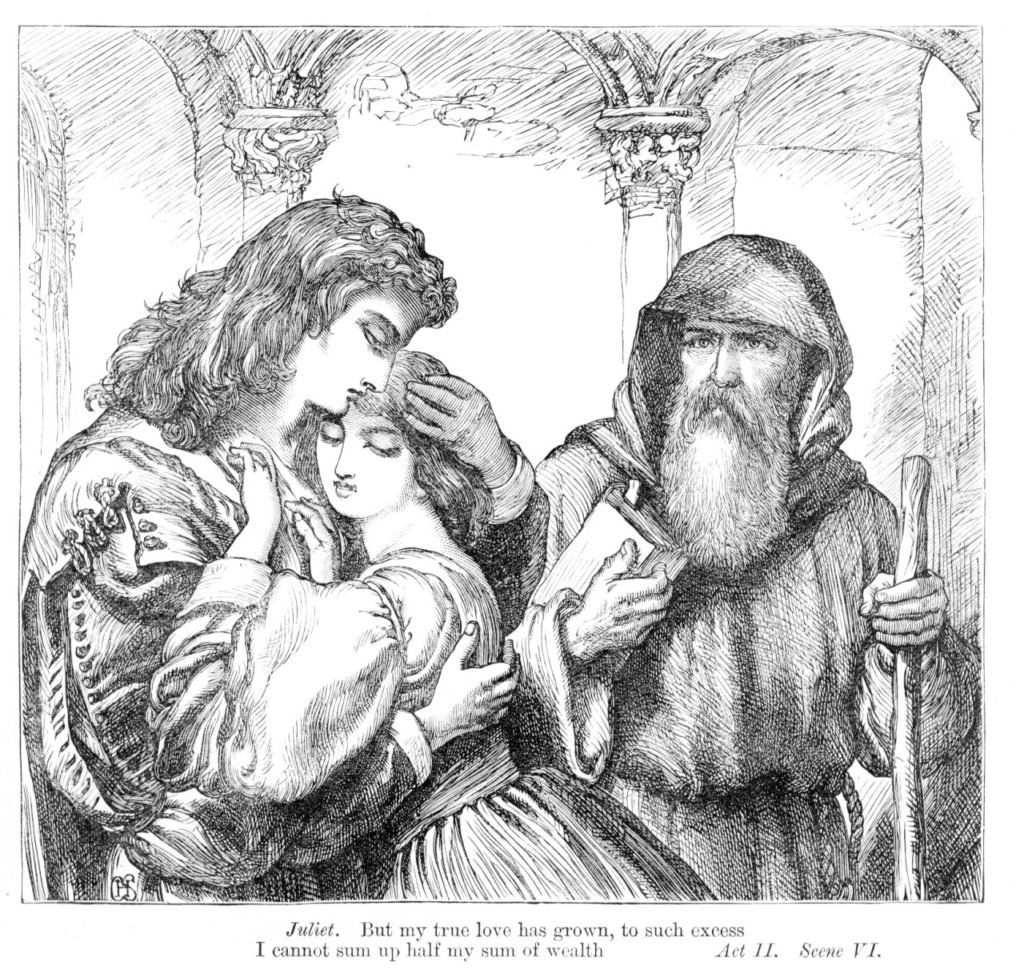
From Michael Goodman in Victorian Illustrated Shakespeare Archive:
https://shakespeareillustration.org/2016/08/07/romeo-juliet-and-friar-laurence/
Attribution 3.0 Unported (CC BY 3.0)
The influence of plague on Shakespeare shows up in Love’s Labour’s Lost. Berowne refers to himself as “A very beadle to a humourous sigh;” (“Love’s Labour’s Lost” 3.2.176). In the same play, Shakespeare uses plague references as a metaphor for the passions Berowne’s companions have for those of Rosaline’s (Bloom 139–40). He blames her for this development based on seeing signs of infection:
Soft, let us see:
Write, 'Lord have mercy on us' on those three;
They are infected; in their hearts it lies;
They have the plague, and caught it of your eyes;
These lords are visited; you are not free,
For the Lord's tokens on you do I see.
("Love's Labour's Lost" 5.2.419–23)
References to the plague appear in many other Shakespeare plays. Plague is often used as a curse, such as Mercutio’s famous repeated imprecations towards the Capulets and the Montagues “a plague o’ both your houses” in Romeo and Juliet (3.1.91). Plague as a curse is also seen in King Henry IV, Part 1, The Tempest, and All’s Well that Ends Well (Elam). Other plays have references to signs of plague infection or occupations related to plague, for example, Mercutio calls Tybalt a rat catcher. In King Lear, the King, furious with one of his daughters, labels her “A plague sore, or embossed carbuncle / In my corrupted blood (“King Lear” 2.4.416–7).
J. P. Conlan has suggested that Shakespeare may have embedded Kellwaye’s advice concerning preventative measures—decke your windows and straw your floores with sweete and holsome herbes—into the dialog and staging of A Midsummer Night’s Dream,and in doing so may have provided a public service. He points to a scene where Titania is beckoning Bottom:
Come, sit thee down upon this flow’ry bed
While I thy amiable cheeks do coy.
And stick musk-roses in thy sleek smooth head
And kiss thy fair large ears, my gentle joy.
("Dream" 4.1.1–4)
Shakespeare has created a safe environment for Titania and Bottom, and presumably for the audience watching as well having spread perfumed flowers about the stage. Until, that is, Puck comes on stage and sweeps away the flowered straw at the end of the play before the fairies enter. The nobles sitting on the stage, knowing the importance of the flowered straw in protecting against plague would be seen by the groundlings to be horrified at this action. They were thus forced to explain their reaction to the confused but concerned groundlings, and in doing so were providing important education in public health.
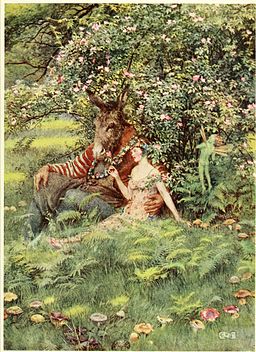
Conclusion
The existence or threat of plague was constant during Shakespeare’s life. Plague during this time was not new to England, so measures were taken to prevent and abort outbreaks. Although this time in history long preceded an understanding of germ theory, many of the measures taken are consistent with modern-day controls used for infectious epidemics. Many of the measures put in place had profound effects on the English society, one in particular, the closing of theaters, had a direct and dramatic affect on Shakespeare. The rate at which he wrote his plays corresponded to the availability of public theaters, and references to plague effects in society can be found in many of the plays. For better or worse, Shakespeare’s work would not look quite like it does today were it not for the plague. All’s well that ends well, until the next plague.
Works Cited
Barroll, J. Leeds. Politics, Plague, and Shakespeare’s Theater: The Stuart Years. Ithaca, NY: Cornell University Press, 1991.
Bevington, David. “What a Plague? Microbes, Quartos, Casting Lists, and Other Shakespearean Contexts.” Modern Philology 91.4 (1994): 459–76.
Bloom, Harold. Shakespeare: The Invention of the Human. New York: Riverhead Books, 1998.
Conlan, J. P. “Puck’s Dread Broom.” English Language Notes 40.4 (2003): 33–41.
Dennis, David T., and Grant L. Campbell. Plague and Other Yersinia Infections. 2005. McGraw Hill. Available: http://www.accessmedicine.com. October 27 2005.
Duncan-Jones, Katherine. Ungentle Shakespeare: Scenes from His Life. Arden Shakespeare. Eds. Richard Proudfoot, Anne Thompson and David Scott Kastan. London: Thomson Learning, 2001.
Elam, Keir. “‘I’ll Plague Thee for That Word’: Language, Performance, and Communicable Disease.” Shakespeare Survey50 (1996): 19–27.
McNeill, William H. Plagues and Peoples. Garden City, NY: Anchor Press, 1976.
Pollack-Pelzner, Daniel. “Shakespeare Wrote His Best Works During a Plague.” The Atlantic March 14, 2020.
Shakespeare, William. “King Henry Iv, Part 2.” The Arden Shakespeare Complete Works. Ed. A. R. Humphreys. Walton-on-Thames Surrey: Thomas Nelson and Sons Ltd, 1998. 393–428.
—. “King Lear.” The Arden Shakespeare Complete Works. Ed. Richard David. Walton-on-Thames Surrey: Thomas Nelson and Sons Ltd, 1998. 631–67.
—. “Love’s Labour’s Lost.” The Arden Shakespeare Complete Works. Ed. Richard David. Walton-on-Thames Surrey: Thomas Nelson and Sons Ltd, 1998. 741–70.
—. “A Midsummer Night’s Dream.” The Arden Shakespeare Complete Works. Ed. Harold F. Brooks. Walton-on-Thames Surrey: Thomas Nelson and Sons Ltd, 1998. 887–910.
—. “Romeo and Juliet.” The Arden Shakespeare Complete Works. Ed. Brian Gibbons. Walton-on-Thames Surrey: Thomas Nelson and Sons Ltd, 1998. 1005–38.
—. “Timon of Athens.” The Arden Shakespeare Complete Works. Ed. H. J. Oliver. Walton-on-Thames Surrey: Thomas Nelson and Sons Ltd, 1998. 1095–122.
—. “Troilus and Cressida.” The Arden Shakespeare Complete Works. Ed. Kenneth Palmer. Walton-on-Thames Surrey: Thomas Nelson and Sons Ltd, 1998. 1151–88.
—. “Venus and Adonis.” The Arden Shakespeare Complete Works. Walton-on-Thames Surrey: Thomas Nelson and Sons Ltd, 1998. 50–62.
Slack, Paul. The Impact of Plague in Tudor and Stuart England. London: Boutledge & Kegan Paul, 1985.
Shapiro, James. New York: Simon & Schuster, 2015.
Totaro, Rebecca. Suffering in Paradise: The Bubonic Plague in English Literature from More to Milton. Medieval & Renaissance Literary Studies. Ed. Albert C Labriola. Pittsburgh, PA: Duquesne University Press, 2005.
Wear, Andrew. Knowledge & Practice in English Medicine, 1550-1680. Cambridge: Cambridge University Press, 2000.Wilson, P. F. The Plague in Shakespeare’s London. Oxford: Oxford University Press, 1927.
Note: A version of this essay is posted at the NYU Literature, Arts and Medicine LitMed Magazine.
